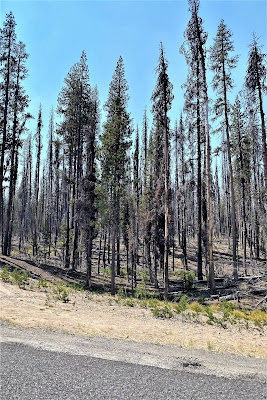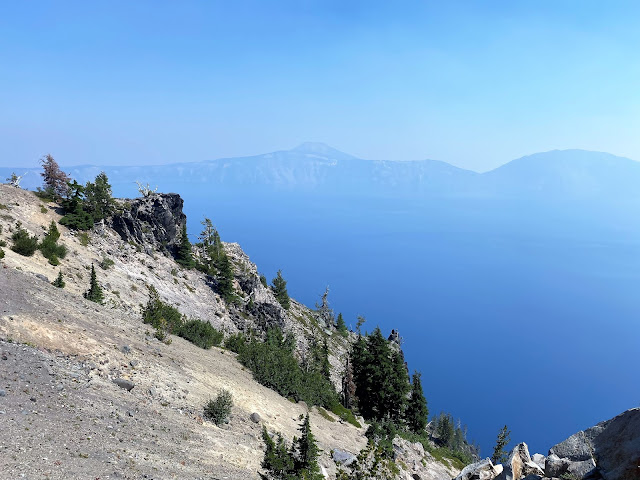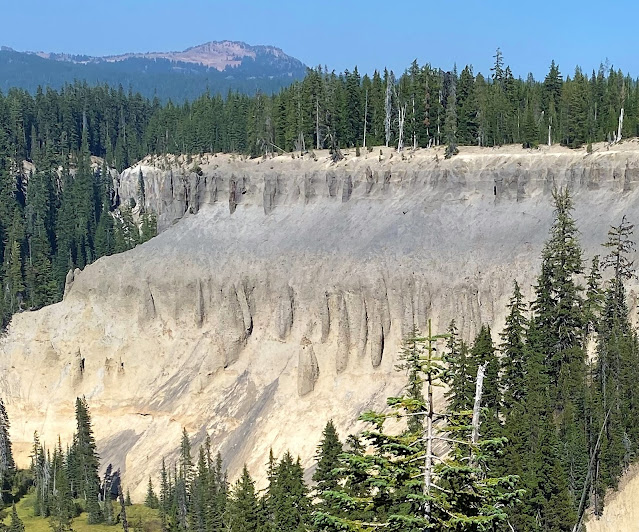September 5, 2020
I was excited to visit Crater Lake, which, at 1,949 feet, is the deepest lake in the United States and the ninth deepest in the world. As its name implies, the lake is in a caldera that was formed by the collapse of a volcano 7,700 years ago.
Crater Lake is less than 10 miles from Diamond Lake, and as we were driving between the two lakes, we noticed a lot of fire damage. The 2020 Oregon wildfire season was one of the most destructive in the history of the state, similar to the 2020 California wildfire season. The fires had started the week we were there, and by the end of the season, over a million acres had burned. These trees had burned in a previous fire, but it gave us an idea of the devastation that the fires would cause in other places.
I was struck by the appearance of these burned trees. Don't they look like Watts Towers in South Los Angeles?
We weren't the only ones on our way to Crater Lake. This is the line at the ranger station.
What a disappointment to finally find a parking spot, make our way to the crater, peer over the edge, and see . . . smoke. We heard that this smoke was from the Northern California fires, which had started several weeks before, but by this time fires were also burning in Oregon. The smoke was trapped inside the walls of the caldera, making it impossible to see the shoreline across the lake from our view area. We had heard much about the beautiful color and clarity of the water, but that too was obscured by the smoke.
One of the nice thing about photos, however, is that they can be tweaked to reveal more than what we could see when we were there. These are still not very sharp, but at least there is some color.
We wish the lake had appeared to be this blue when we saw it!
Even with the photo editing, the far shoreline remains a vague boundary between the water and the caldera wall.
There were lots of warnings to stay away from the edge, and lots of people who stood on the edge anyway.
These next two photos show the caldera walls. There are no canyons cutting through these walls because no rivers flow in or out of the caldera. The water comes completely from rain and snow melt!
This is Wizard Island, a volcano within the volcano. After the massive eruption of 12,000-foot Mount Mazama 7,700 years ago, which formed this deep basin, smaller eruptions continued within the caldera, sealing the floor and allowing water to accumulate. During this time, a cinder cone formed, which can be seen in the photo below. It has its own small crate on its summit.
This panoramic shot makes it look like there weren't many people there, but it was packed, so packed that it made us nervous because many people were not wearing face masks as was the rule at the time. We didn't stay long. I hope some day we will be able to return under more favorable conditions.
We stopped one more time on our way down the mountain at The Pinnacles overlook.
This geologic formation of vertical stripes was formed during the active volcanic phase. There is another section of The Pinnacles that is even more dramatic, but unfortunately we didn't see it.
We continued on to Klamath Falls, about a 60-mile drive. The temperature was pleasant when we got there in the evening, but not that the air quality was unhealthy, and we were not even near the fires at that point.
Klamath Falls, located just 25 miles north of the California-Oregon border, was founded in 1867 but had been inhabited by indigenous people for at least 4,000 before European settlers appeared on the scene. Today it has a population of about 21,000. It is a pretty and artsy little town, and it was a great place to spend the night.
We used Yelp to look for a place to eat and ended the Thai Orchid Cafe, which had this great tree with its crocheted sleeves growing right out front.
All I can say is that it must get cold in Klamath Falls, which has an elevation of 4,094 feet. Maybe we are supposed to "Imagine" the snow levels?
We had delicious green curry and red curry. We recommend this as a good stopping place after a visit to Crater Lake!
Next: More wildlife and another volcano


























Crater Lake was a huge disappointment. Labor Day Weekend with huge crowds and no visibility. Probably difficult to have picked a worse day.
ReplyDelete